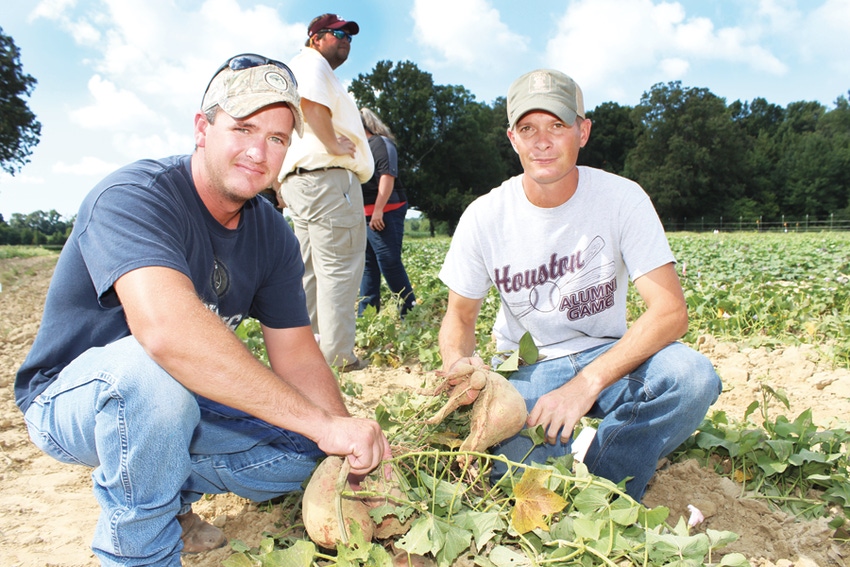

STEVE MEYERS
Weed escapes can be “exceptionally difficult” in sweet potato production due to the lack of registered herbicides for postemergence control of broadleaf weeds, says Steve Meyers, Mississippi State University Extension regional sweet potato specialist.
There are a number of reasons weeds can make it through herbicide applications, he said at the sweet potato field day held at the Pontotoc Ridge/Flatlands Experiment Station at Algoma, Miss., where producers had an opportunity see demonstration plots of various herbicides and herbicide combinations.
Growers should keep these facts in mind when planning for the 2014 growing season, Meyers says.
Ag news delivered daily to your inbox: Subscribe to Delta Farm Press Daily.
“Preemergence herbicides — Valor, Command, and Dual Magnum — used in sweet potato production require rainfall or irrigation for activation. If weeds emerge before rainfall moves the herbicide into the soil, control is reduced.
“Excessive rainfall can also result in breaks in weed control by promoting successive weed germination events and moving herbicide either deeper into the soil or off the shoulders of the bed.”
Assuming soil-applied herbicides are activated by rainfall, weed control can still be compromised by premature cultivation, Meyers says. “Cultivating fields where there is limited to no weed pressure early in the growing season exposes weed seeds deeper in the soil to ideal germination conditions nearer the soil surface.
Mississippi sweet potato research aims for better yields, quality
“If herbicide activity has been good, wait to cultivate. Data from the past 20 years of weed control research in sweet potatoes indicate that a cultivation between three weeks and four weeks after planting is ideal if early residual herbicide applications have been successful in holding weeds back.
“This delayed cultivation could be followed with a broadcast lay-by application of Dual Magnum, which — assuming an activating rainfall occurs — can help keep fields clean until vine closure.”

ANDY LANDRETH, from left, Vardaman, Miss.; Mike Langley, Houston, Miss.; Norman Clark, Vardaman, all sweet potato growers; and Trent Barnett, Calhoun County Extension agent at Calhoun City, Miss., were among those attending the field day.
The final common reason for weed escapes, Meyers says, “simply comes down to mode of action. Most herbicides are selective in which weeds they control or suppress. Knowing which weeds are present in a field and selected the right herbicide are important.
“This year, many production fields had coffeeweed (hemp sesbania) and hophornbeam copperleaf standing tall above the sweet potato canopy. While Command and Dual Magnum, or Lasso/Intrro control numerous weed species, they don’t provide satisfactory control of those two weeds. Currently, Valor is the best bet for controlling coffeeweed and suppressing copperleaf.
“Unfortunately, not every troublesome weed in sweet potatoes has a registered and effective herbicide.”
Reniform nematodes have been documented this year in a number of Mississippi sweet potato fields, Meyers says.
“It would be easy to link increased nematode concerns this season with the inability to apply a preplant application of K-PAM because of the wet spring. But, fumigation should be thought of as a short term solution to a long term problem.”
One of the best options for addressing increasing nematode pressure is crop rotation, he says.
“Growers with nematode pressure who can rotate fields to corn, sorghum, or peanuts should give it serious consideration. Doing so would not only help reduce the nematode populations, but may help put a dent in nutsedge populations, since corn is a much better competitor with nutsedge than sweet potatoes.” Unfortunately, Meyers says, cotton and soybeans are not good rotation options. “Nematodes enjoy a field of cotton and soybeans as much as they do sweet potatoes.”
For further sweet potato information, check the sweet potato page on the Mississippi State University MSU Cares website and the Mississippi Crops Situation blog.
About the Author(s)
You May Also Like




